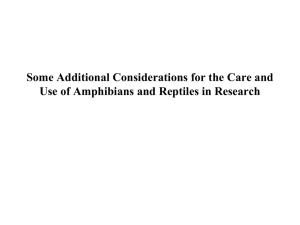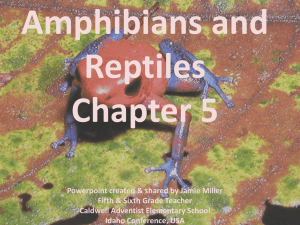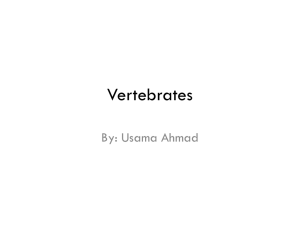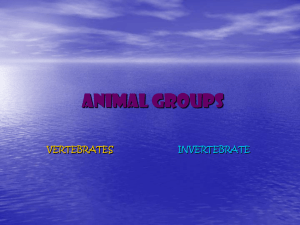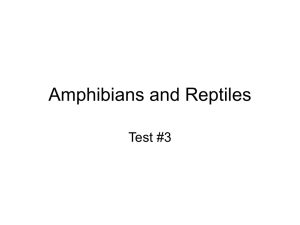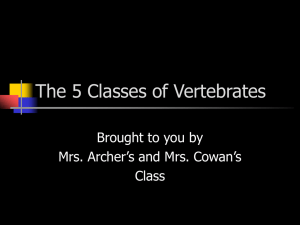Amphibians and Reptiles - Vernon Hills High School
advertisement
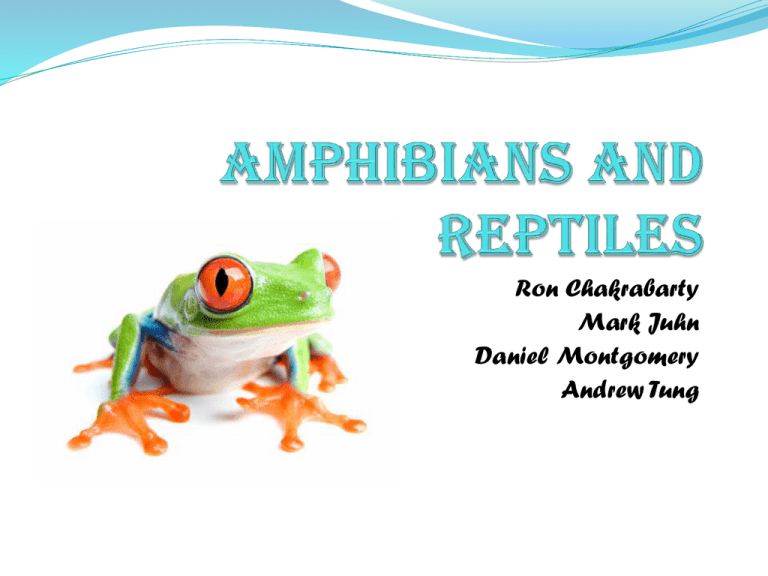
Ron Chakrabarty Mark Juhn Daniel Montgomery Andrew Tung Family Amphibia Amphibians – General/Unique Characteristics Moist, glandular skin with no scales Feet lack claws and are often webbed Possession of gills at some point in its life Lack of amnion in the egg Embryonic membrane and surrounds and protects the embryo Amphibians - Evolution First vertebrates to begin exploring terrestrial land Earliest fossil found about 400 million years Most likely evolved from fish Air bladder mutated/adapted to lungs Fins evolved into limbs? To give stronger support Amphibians – Classification into Orders There are three different orders for an amphibian Anura – 4200 species of frogs and toads Urodela – 430 species of newts and salamanders Gymniophiona – 165 known species of caecilians Amphibians - Anura Consists of frogs and toads Have tails as tadpoles, but lack tails as adults Long hind legs for jumping and swimming Live mostly in freshwater, but some live in drier habitats Common Anurans – bullfrog, spring peeper, American toad, spade-foot toad The difference between a frog and a toad is that toads have shorter legs, drier skin, and more warts than frogs. Length – 1 to 12 inches Eat mainly insects and small invertebrates Amphibians – Urodeles – also called Caudata Consist of newts and salamanders Have long tails and small, underdeveloped feet. Includes the largest amphibian in the world – the Giant Salamander lives in Japan and can be up to 5 feet long. Live near water or in moist soil Eat insects and some smaller invertebrates Includes one genus that is shaped like an eel – no legs or pelvis and has gills and lungs Amphibians - Gymniophiona Consists of caecilians Small, worm-shaped amphibians Blind Legless Only 165 species known because some are so small Largest caecilian is 4.5 feet long Amphibians - Symmetry Amphibians have bilateral symmetry They can be divided into identical halves across exactly one plane Cephalized Concentration of brain cells near the anterior end of the amphibian Amphibians – Body cavity All amphibians are coelomates All have a true coelom A coelom is a hollow, fluid-filled body cavity that is lined both internally and externally by mesoderm. Provides support for the chest Amphibians – Structural Support Skeleton - General Vertebrae – form a backbone Limbs – support while walking or standing Pectoral girdle – shoulder and supporting bones from front limbs Pelvic girdle – “hips” from back limbs Cervical vertebra – neck movement Amphibians – Skeleton Frogs – specialized bones in skeleton, different from other amphibians Radio-ulna – “forearm” Tibiofibula – “calf” Phalanges – fingers adapted for jumping – on all four limbs Bones are generally thicker (for impact when landing) Amphibians – Skin Serves as method of respiration and as a method of protection Makes them more affected by pollution – chemicals can diffuse into the body Health of amphibians in one habitat represents the condition of their environment Amphibians - Respiration Larvae have gills Allow oxygen into the organism when it is underwater Larvae undergoes metamorphosis Gills disappear and lungs are made Amphibians - Respiration Adult amphibians can breathe through their skin and lungs. Pulmonary respiration (breathing through lungs) – takes in air through nostrils and mouth Adult frogs have to voluntarily force air down their throats (buccal pumping) because they lack a diaphragm, and this is why they mainly use cutaneous respiration. Amphibians - Respiration Cutaneous respiration (breathing through skin) – many amphibians use this type of respiration as their main type of breathing and use their lungs as backup Skin is moist and permeable Allows diffusion of oxygen, water, and carbon dioxide However, this makes amphibians vulnerable to dehydration Amphibians – Transportation and Circulation Amphibians have a three-chambered heart Circulatory system has two loops Pulmonary circulation Carries deoxygenated blood to lungs from heart Moves through contraction of atrium Systemic circulation Oxygenated blood from heart to rest of body Amphibians – Transportation and Circulation Blood in heart Deoxygenated blood enters right atrium Pulmonary veins carry oxygenated blood from lungs to left atrium Oxygenated and deoxygenated blood mix in ventricle Ventricle pumps blood to lungs All known as the “double-loop” system Amphibians – Digestive System All adults are carnivorous Many larva are herbivorous Frogs Other larva are carnivorous Salamander Amphibians - Digestive System Pharynx – opens into the esophagus Esophagus – elastic tube that brings food down from the pharynx to the stomach Allows amphibian to swallow large amounts of food Stomach – has tiny glands that secrete gastric juices Digests/breaks down food Small intestine – Digestion is completed Duodenum – upper portion Ileum – coiled middle portion of small intestine Mesentery – holds small intestine in place Large Intestine – Holds waste Amphibians – Excretion Small intestine empties into the large intestine Indigestible waste is collected Processed by kidneys Pushed into cloaca Waste from kidneys, urinary bladder, eggs and sperm pass through cloaca Waste exits through vent Amphibians – Water Balance Amphibians skin is permeable Water and nutrients can come in through the skin However, this also makes it more vulnerable to dehydration because water can diffuse out of their skin in dry environments Therefore, amphibians must live in wet environments Many are active only at night when water loss is minimized Amphibians – Water Balance Urine Flows from kidneys to cloaca through urinary ducts Goes to urinary bladder Water-storing organ Amphibian larva excrete nitrogen compounds as ammonia Very toxic, so must be excreted quickly or diluted with water To conserve water, adults instead transform ammonia into urea Less toxic Excreted with less water although uses energy Amphibians – Reproduction Frogs come out of hibernation in the first days of spring Migrate to ponds and streams, where males attract females by using vocal sacs Females only respond to frogs of the same species When females come, males climb onto their backs and “hug” them – called amplexus – until eggs are laid through the vent . Into the water for most amphibians When eggs are laid, males discharge sperm onto the eggs – direct external fertilization Amphibians – Reproductive System Males Sperm cells develop in the testes Goes to urinary tract during mating season Female Eggs develop in the ovaries Eggs enlarge, mature, and move to the body cavity during breeding season Leave female through oviducts and are coated with a protective slime Amphibians - Development Tadpoles hatch within a few days and develop gills Eventually, a mouth opens Goes through metamorphosis – Changes from an aquatic larva to an adult Legs Lungs Teeth Tail disappears Metamorphosis happens because of thyroxine Produced in thyroid, circulates through blood, stimulates metamorphosis Amphibians – Development Alternative reproductive patterns Some amphibians lay eggs in a warmer environment Under a rock, in a log, in a tree Some frogs build a nest Made out of mucus, whipped into a frothy material by kicking it rapidly Some do not go through metamorphosis Salamanders that remain in the larval stage for their whole life No thyroxine produced Some do not go through the larval stage Hatch from eggs as small version of adult Amphibians – Nervous System Tympanic Membrane – eardrum Columella – bone that transmits sounds from the eardrum to the inner ear Olfactory Lobes – sense of smell Optic Lobes - sight Amphibians – Nervous System Brain Same size as fish Cerebrum – responsible for learning Cerebellum – muscle coordination Nerves extend directly from brain to body, protected by spinal cord Lateral line – detect vibrations in water Lost during metamorphosis Family Reptilia History Evolved from amphibians Oldest known reptiles date back to early carboniferous period (359- 299 m.y.a) Small, four-legged Ate insects Lived in dry climates Dinosaurs Evolved from thecodonts. Success Legs placed under body Adapted to dry climates Mass extinction Dinosaurs Extinction Asteroid Impact Hypothesis Huge asteroid hit Yucatán Peninsula Dust cloud Supported by high amount of iridium in sediments Multiple Impact Hypothesis Bad environmental conditions Many asteroid impacts Reptiles – Structural Support/ Body Cavity/Symmetry Symmetry- Bilateral Body Cavity- Coloem Structural Support- Endoskeleton Have breast bone to guard lungs and heart Reptiles - Respiration Have large lungs for gas exchange Lunges divided into chambers Alveoli- small sacs that are created by the folding of the lungs. (more oxygen) Snakes Only right lung functions, as big as half the length of body Left is nonfunctional or gone Reptiles - Respiration Lungs are filled by expanding rib cage Ribs contract to normal and air is released from lungs Similar to human respiration Reptiles - Water Balance/Excretion Respiratory and excretion systems help reptiles conserve water All tissues for respiration are internal to keep moisture Land reptiles give of nitrogenous waste in the form of uric acid Reptiles lose little water in urine Reptiles – Water Balance/Excretion Respiratory and excretion systems help reptiles conserve water All tissues for respiration are internal to keep moisture Land reptiles give of nitrogenous waste in the form of uric acid Reptiles lose little a water in urine Reptiles - Classification Classified into four orders Chelonia – Turtles and tortoises Crocodilia – Alligators and crocodiles Squamata – Lizards and snakes Rhynchocephalia - tuataras Reptiles - Chelonia 250 species of turtles and tortoises Tortoise- Terrestrial Turtle- Aquatic Ancient chelonians- like modern turtles and tortoises Turtle design Body enveloped in a shell Carapace- Dorsal of the shell Plastrons- Underside of shell Ribs attached to inner carapace Pelvic and pectoral girdles- inside ribs Sharp beak Order Chelonia Tortoise design Domed carapace defense from predators limbs covered in thick scales Chelonia mydas (green sea turtle) Reptiles - Chelonia Habitats Some always terrestrial or aquatic, some live in both Shells and limbs- adapted to different habitats Aquatic turtles- streamlined, disk-shaped shell for turning and webbed feet Limbs are flippers for swimming Reproduction Offspring born through eggs Female finds a location, makes a hole, puts eggs in it, covers nest Leaves young alone to hatch Crocodilia Crocodiles Closest related to dinosaurs Heavy-bodied and aquatic Crocodylus rhombifer (Cuban Crocodile) Have a valve at the back of the throat Prevents water from entering the air passage Reptiles - Squamata Lizards Eat insects Some plants Predator Protection Agility, speed, and camouflage Autotomy Reptiles - Squamata Snakes No legs Ancestors lived in thick vegetation, legs slowed them Backbone of 100 to 400 vertebrae Ribs attached Framework for muscles Muscles affect skin, scales enlarge and contract which moves snake Kill by constriction or injecting venom Notechis scutatus (Tiger Snake) (Elapid) Dispholidus typus (Boomslang Snake) (grooved teeth in the back of the mouth) Bitis gabonica (Gaboon Viper Snake) Boa constrictor Reptiles - Rhynchocephalia Ancient, only Tuataras from genus Sphenodon Tuatara means spiny crest Live only on New Zealand Burrow during the day and eat small insects, worms, and animals during the night. Sphenodon Punctatus (Tuataras) Reptiles – Transportation and Circulation Two circulatory loops Pulmonary loop Carries deoxygenated blood from the heart to the lungs Systematic loop Carries oxygenated blood from the heart to the tissues Carries deoxygenated blood back to the heart Two atria, two ventricles or one divided by the septum Reptiles – Transportation and Circulation High flexibility in a reptilian heart Pulmonary arteries can restrict Skips lungs. Deoxygenated bloodbody Some take blood from lungs for energy conservation Reptiles stop breathing when inactive When active, blood goes to lungs, and more oxygen goes to the muscles Reptiles – Nutrition and Digestion Mouth, tongue, teeth, esophagus, stomach, and rectum Simple digestive tract Moderately sized gut Don’t chew food like mammals Some herbivorous reptiles swallow rocks called gastrolithes to help digestion Reptiles- Most acidic digestion system of any animal Reptiles – Water Balance/Excretion Two kidneys Reptiles use the colon to reabsorb water Land reptiles remove nitrogenous waste in uric acid Little water lost Some reptiles can get rid of salt with salt glands and nasal areas Reptiles – Nervous System Brain size= an amphibian Cerebrum is larger Good vision Large optic lobes Hearing Sound waves hit tympanic membrane (eardrum) Columella moves and takes sound to the inner ear Recognized in inner ear by receptors Nervous System Cont. Jacobson’s organ On roof of mouth Senses odors Pit vipers Detect warm-blooded prey body heat Heat-sensitive pit under eyes Detects position of the prey Reptiles – Reproductive System Three patterns Oviparity Ovoviviparity Viviparity Differ in length of time eggs are in the female and the nutrition given Reptiles – Reproductive System Oviparity Female reproductive tract puts shell on egg Egg placed in an optimal place Ovoviparity Eggs stay in female body Right before hatching-eggs are laid Or hatch in the female Reptiles – Reproductive System Viviparity No shell Stays in female body until born Placenta give nutrients and oxygen motherembryo Placenta formed from egg membranes Reptiles – Reproductive System Many mothers don’t care for eggs or offspring Some lizards and snakes protect and keep eggs warm until hatching Most care- Crocodiles and alligators Female crocodile builds a nest Carries offspring in mouth to water The End (Works Cited on next page) Amphibians and Reptiles Works Cited "Amphibian." msn encarta. 2008. Microsoft. 24 Mar 2009 <http://encarta.msn.com/encyclopedia_761574532/Amphibian_(animal).html#s11>. "Frog Blog - Amphibian Respiration." houstonzooblog.com. 10 Mar 2008. Houston Zoo Blog. 23 Mar 2009 <http://www.houstonzooblog.com/frog_blog/2008/03/amphibianrespi.html>. http://www.mcwdn.org/Animals/Reptile.html Lerner, Lee. "Amphibians." The Gale Encyclopedia of Science 2008: 189-191. Gale Virtual Reference Library. Gale. Vernon Hills High School. 23 Mar 2009 <http://go.galegroup.com/>. Nagel, Rob. "Amphibians." UXL Encyclopedia of Science 2002: 134-137. Gale Virtual Reference Library. Gale. Vernon HillsHigh School. 23 Mar 2009 <http://go.galegroup.com>. Postlethwait, John, and Janet Hopson. Modern Biology. Austin: Harcourt Education, 2008. W. Ben Cash, Richard G. Zweifel, T. R. Smithson, "Amphibia", in AccessScience@McGraw-Hill, http://www.accessscience.com, DOI 10.1036/10978542.029600
